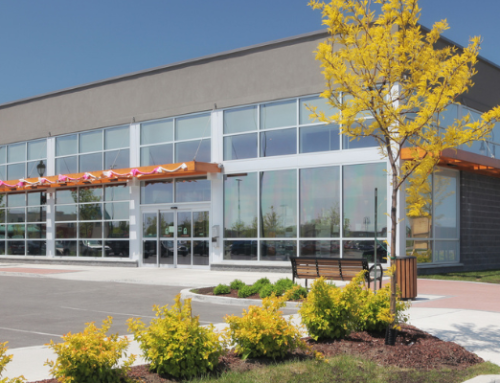On August 9, 2022, the CHIPS Act became law, and with it several years and tens of billion dollars in promised funding for advanced semiconductor manufacturing. Top global manufacturers like Intel and Samsung have already signaled their plans to relocate and expand operations in the U.S. as a result and others will undoubtedly follow. This is good news for the construction industry, but the benefits may take time to see.
About the CHIPS Act
The Creating Helpful Incentives to Produce Semiconductors (CHIPS) and Science Act is a $280 billion investment in advanced manufacturing, research, and technology. Through a combination of federal subsidies, grants, loan guarantees, investments, and tax credits, the CHIPS Act focuses on strengthening national security, boosting domestic innovation, and shoring up the semiconductor supply chain. The CHIPS Act will funnel money directly to manufacturers and impact other industries, suppliers, and partners – from education and research to construction.
A big piece of the CHIPS Act is a new tax credit. With a $24 billion price tag, the Advanced Manufacturing Investment Credit is equal to 25 percent of eligible investment projects and incentivizes building and expanding domestic semiconductor manufacturing facilities.
The tax credit will provide a direct-pay, refundable credit for facilities with a primary purpose of making semiconductors or semiconductor manufacturing equipment. It applies to tangible property that can be amortized and depreciated that is placed in service between January 1, 2023 and December 31, 2026. Projects already underway may qualify.
There are restrictions and limitations for taxpayers; for example, manufacturers would be prohibited from building or expanding a chip facility in China and other nations where there’s a national security concern for ten years.
Impact of the CHIPS Act on Construction
It’s estimated there are about $33 billion in semiconductor fabrication plants in the planning stage – promising news for the construction industry, which has been hit with record-high costs, ongoing labor shortages, and stalled growth since COVID. Going into a likely recession, the CHIPS Act will provide some reassurance to many construction contractors.
More than semiconductor plants, the CHIPS Act has the potential to influence construction projects in ancillary areas, too – like schools, research and technology hubs, supplier facilities, telecommunications, and infrastructure.
The construction industry can look forward to long-term job growth and economic development. As a result of the CHIPS Act, communities across the country are already approving multi-million dollar projects to build and improve roads, water infrastructure, and new buildings. Some states are also paving the way for expansive investments in new semiconductor factories.
Even if a contractor isn’t directly involved or has experience in semiconductor plants or advance manufacturing, or government contracts, there are likely to be several related projects to look forward to in the years to come.
In Virginia, a Manassas-based semiconductor plant is already looking to expand.
Then there is talk about lobbying for one of the 20 regional tech hubs authorized in the CHIPS Act in Southwest Virginia.
There are also active conversations to locate advanced manufacturing and innovation projects in the state. Three mega sites in Virginia could support new manufacturing, research, and development projects that the CHIPS Act could potentially subsidize. That’s on top of eight other sites with more than 1,000 acres that are in development. The Virginia Business Ready Sites Program has been securing funding for these and other approved industrial sites.
Challenges for Contractors
One of the biggest concerns for construction contractors is labor. Construction labor is already strained, and with billions of dollars in new projects coming over the next several years, finding skilled workers represents a major challenge. Contractors will need to find specialized labor who can build the kind of plants required.
Meeting the typical project parameters may also be a challenge. As noted in Construction Dive, “These jobs typically require progressive design-build and engineering, procurement and construction approaches, as well as heightened security.” Workers may need security clearances in addition to certain skillsets, on top of prevailing wage on certain projects. That can be tough for contractors to fulfill.
When funds will actually become available is also anyone’s guess. It probably won’t be in 2022. Money from the Infrastructure Act is just starting to flow through to projects, and that was passed several months ago. While the CHIPS Act is meant to spur domestic advanced manufacturing, research, and development, it’s not an immediate windfall.
Prevailing Wage
Also looming in the CHIPS Act labor discussion is the Department of Labor’s request in 2021 to expand the scope of prevailing wage. Under Davis-Bacon, prevailing wage combines an hourly rate plus fringe benefits. It applies to federally funded construction projects of more than $2,000 and extends to contractors and subcontractors alike. The DOL is arguing that changing the old definition in the 1980s contributed to inflation. Construction stakeholders argue that reverting to a revised definition of prevailing wage would force project costs higher, dampen productivity and industry growth, discourage competition, and more.
In the short-term, there’s not much to do except wait; however, contractors that anticipate bidding on semiconductor manufacturing expansions or builds may want to look into the CHIPS Act’s workforce training funding. There is widespread support for most elements of the CHIPS Act, and the hope that reinvesting in advanced manufacturing can strengthen the domestic supply chain.
PBMares will continue to monitor ongoing developments, especially as they relate to tax incentives, business opportunities, and labor implications for the construction industry. Contact Construction and Real Estate Team Leader Jennifer French, CPA with questions.





